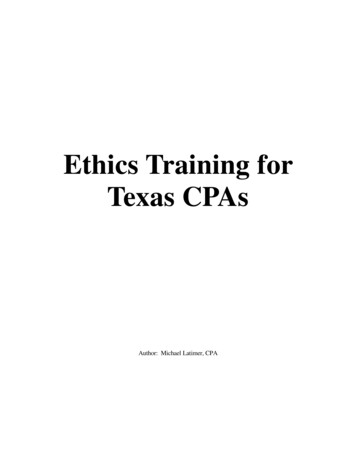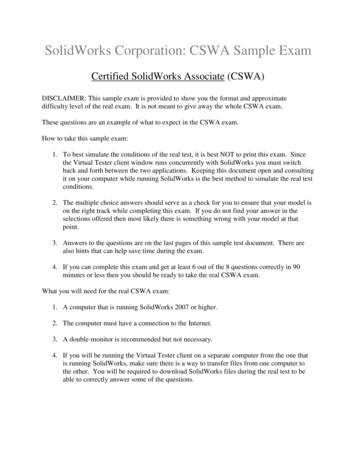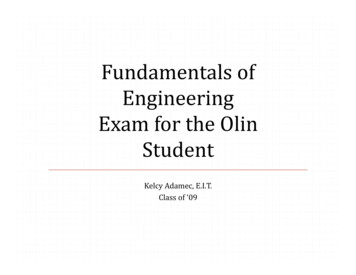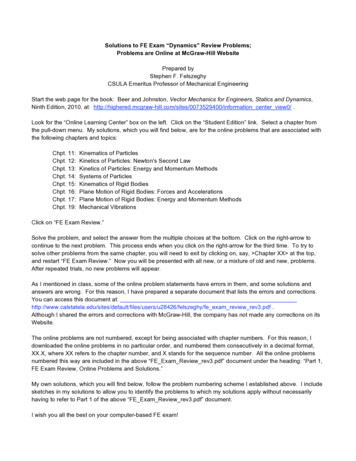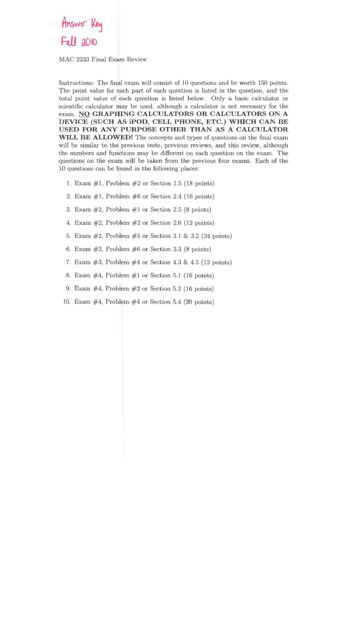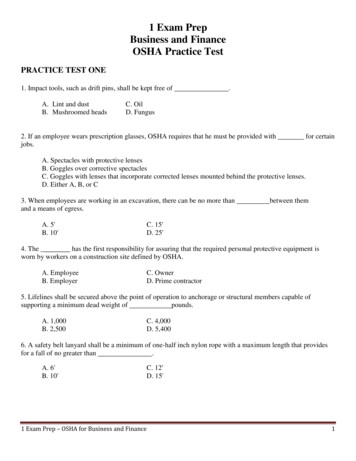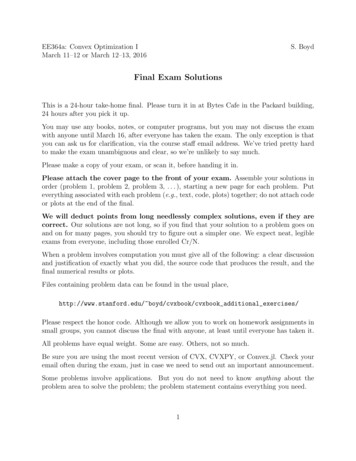
Transcription
EE364a: Convex Optimization IMarch 11–12 or March 12–13, 2016S. BoydFinal Exam SolutionsThis is a 24-hour take-home final. Please turn it in at Bytes Cafe in the Packard building,24 hours after you pick it up.You may use any books, notes, or computer programs, but you may not discuss the examwith anyone until March 16, after everyone has taken the exam. The only exception is thatyou can ask us for clarification, via the course staff email address. We’ve tried pretty hardto make the exam unambiguous and clear, so we’re unlikely to say much.Please make a copy of your exam, or scan it, before handing it in.Please attach the cover page to the front of your exam. Assemble your solutions inorder (problem 1, problem 2, problem 3, . . . ), starting a new page for each problem. Puteverything associated with each problem (e.g., text, code, plots) together; do not attach codeor plots at the end of the final.We will deduct points from long needlessly complex solutions, even if they arecorrect. Our solutions are not long, so if you find that your solution to a problem goes onand on for many pages, you should try to figure out a simpler one. We expect neat, legibleexams from everyone, including those enrolled Cr/N.When a problem involves computation you must give all of the following: a clear discussionand justification of exactly what you did, the source code that produces the result, and thefinal numerical results or plots.Files containing problem data can be found in the usual place,http://www.stanford.edu/ boyd/cvxbook/cvxbook additional exercises/Please respect the honor code. Although we allow you to work on homework assignments insmall groups, you cannot discuss the final with anyone, at least until everyone has taken it.All problems have equal weight. Some are easy. Others, not so much.Be sure you are using the most recent version of CVX, CVXPY, or Convex.jl. Check youremail often during the exam, just in case we need to send out an important announcement.Some problems involve applications. But you do not need to know anything about theproblem area to solve the problem; the problem statement contains everything you need.1
1. Portfolio optimization using multiple risk models. Let w Rn be a vector of portfolioweights, where negative values correspond to short positions, and the weights arenormalized such that 1T w 1. The expected return of the portfolio is µT w, whereµ Rn is the (known) vector of expected asset returns. As usual we measure the riskof the portfolio using the variance of the portfolio return. However, in this problem wedo not know the covariance matrix Σ of the asset returns; instead we assume that Σis one of M (known) covariance matrices Σ(k) Sn , k 1, . . . , M . We can think ofthe Σ(k) as representing M different risk models, associated with M different marketregimes (say). For a weight vector w, there are M different possible values of therisk: wT Σ(k) w, k 1, . . . , M . The worst-case risk, across the different models, is givenby maxk 1,.,M wT Σ(k) w. (This is the same as the worst-case risk over all covariancematrices in the convex hull of Σ(1) , . . . , Σ(M ) .)We will choose the portfolio weights in order to maximize the expected return, adjustedby the worst-case risk, i.e., as the solution w? of the problemmaximize µT w γ maxk 1,.,M wT Σ(k) wsubject to 1T w 1,with variable w, where γ 0 is a given risk-aversion parameter. We call this themean-worst-case-risk portfolio problem.P?(a) Show that there exist γ1 , . . . , γM 0 such that Mk 1 γk γ and the solution wof the mean-worst-case-risk portfolio problem is also the solution of the problemPT (k)maximize µT w Mk 1 γk w Σ wsubject to 1T w 1,with variable w.Remark. The result above has a beautiful interpretation: We can think of theγk as allocating our total risk aversion γ in the mean-worst-case-risk portfolioproblem across the M different regimes.Hint. The values γk are not easy to find: you have to solve the mean-worst-caserisk problem to get them. Thus, this result does not help us solve the mean-worstcase-risk problem; it simply gives a nice interpretation of its solution.(b) Find the optimal portfolio weights for the problem instance with data given inmulti risk portfolio data.*. Report the weights and the values of γk , k 1, . . . , M . Give the M possible values of the risk associated with your weights,and the worst-case risk.Solution.(a) We can reformulate the mean-worst-case-risk portfolio problem asminimize µT w γtsubject to wT Σ(k) w t, k 1, ., M,1T w 1.2
with variables w Rn and t R. Let λk be a dual variable for the kth inequality constraint, and ν be a dual variable for the equality constraint. The KKTconditions are thenP µ ν1 k 2λkPΣ(k) w 0γ k λk 01T w 1T (k)w Σ w tT (k)λk w Σ w t 0, k 1, ., Mγ 0.Similarly, the KKT conditions for the problemPT (k)maximize µT w Mk 1 γk w Σ wTsubject to 1 w 1are µ α1 Pk2γk Σ(k) w 01T w 1,(1)(2)where α is a dual variable for the equality constraint. Let (w? , t? , ν ? , λ? ) be?optimal for the mean-worst-case-risk portfolio problem,P and chooseP ? γk λk , k 1, . . . , M . With this choice of the γk , we have that k γk k λk γ from theoptimality conditions for the mean-worst-case-risk portfolio problem. Moreover,(w, α) (w? , ν ? ) satisfy (2), so w? is optimal for (1).(b) The results 52706-0.61401-0.49879-0.254070.11484gamma k values:0.292320.000000.000000.465800.142303
0.09958risk orst case risk:0.12188The following Matlab code solves the problem.clear all; clcmulti risk portfolio data;cvx begin quietvariables t w(n)dual variables gamma dual{M}maximize(mu*w - gamma*t)subject togamma dual{1}: w’*Sigma 1*wgamma dual{2}: w’*Sigma 2*wgamma dual{3}: w’*Sigma 3*wgamma dual{4}: w’*Sigma 4*wgamma dual{5}: w’*Sigma 5*wgamma dual{6}: w’*Sigma 6*wsum(w) 1cvx end% weightsw% dual variablesdisp(’gamma k values’);disp(gamma dual{1});disp(gamma dual{2});disp(gamma dual{3});disp(gamma dual{4});disp(gamma dual{5});disp(gamma dual{6});4 tttttt
% risk valuesdisp(’risk values’);disp(w’*Sigma 1*w);disp(w’*Sigma 2*w);disp(w’*Sigma 3*w);disp(w’*Sigma 4*w);disp(w’*Sigma 5*w);disp(w’*Sigma 6*w);% worst case risktThe following Python code solves the problem.import numpy as npimport cvxpy as cvxfrom multi risk portfolio data import *w cvx.Variable(n)t cvx.Variable()risks [cvx.quad form(w, Sigma) for Sigma in(Sigma 1, Sigma 2, Sigma 3, Sigma 4, Sigma 5, Sigma 6)]risk constraints [risk t for risk in risks]prob cvx.Problem(cvx.Maximize(w.T*mu - gamma * t),risk constraints [cvx.sum entries(w) ��.join([’{:.5f}’.format(weight) for weight in w.value.A1]))print(’\ngamma k t(risk.dual value)for risk in risk constraints]))print(’\nrisk t(risk.value) for risk in risks]))print(’\nworst case risk:\n{:.5f}’.format(t.value))The following Julia code solves the problem.using Convex, SCSset default solver(SCSSolver(verbose false))5
include("multi risk portfolio data.jl");w Variable(n)t Variable()risk 1risk 2risk 3risk 4risk 5risk 6 rm(w,quadform(w,Sigma 1)Sigma 2)Sigma 3)Sigma 4)Sigma 5)Sigma 6)p maximize(mu*w - gamma * t, [sum(w) aintsp.constraintsp.constraints risk 1risk 2risk 3risk 4risk 5risk 6 (w.value, 5))println("\ngamma k values:")for i ln("\nrisk values:")for sigma in (Sigma 1, Sigma 2, Sigma 3, Sigma 4, Sigma 5, Sigma ntln("\nworst case risk:")println(round(t.value, 5))6
2. Minimum possible maximum correlation. Let Z be a random variable taking values inRn , and let Σ Sn be its covariance matrix. We do not know Σ, but we do knowthe variance of m linear functions of Z. Specifically, we are given nonzero vectorsa1 , . . . , am Rn and σ1 , . . . , σm 0 for whichvar(aTi Z) σi2 ,i 1, . . . , m.For i 6 j the correlation of Zi and Zj is defined to beΣijρij p.Σii ΣjjLet ρmax maxi6 j ρij be the maximum (absolute value) of the correlation amongentries of Z. If ρmax is large, then at least two components of Z are highly correlated(or anticorrelated).(a) Explain how to find the smallest value of ρmax that is consistent with the given information, using convex or quasiconvex optimization. If your formulation involvesa change of variables or other transformation, justify it.(b) The file correlation bounds data.* contains σ1 , . . . , σm and the matrix A withcolumns a1 , . . . , am . Find the minimum value of ρmax that is consistent with thisdata. Report your minimum value of ρmax , and give a corresponding covariancematrix Σ that achieves this value. You can report the minimum value of ρmax toan accuracy of 0.01.Solution.(a) Using the formula for the variance of a linear function of a random variable, wehave thatvar(aTi Z) aTi var(Z)ai aTi Σai ,which is a linear function of Σ. We can find the minimum value of the maximumcorrelation among components of Z that is consistent with the data by solvingthe following optimization problem.minimize maxi6 j ρij subject to aTi Σai σi2 ,Σ 0.Observe thati 1, . . . , m Σij ρij pΣii Σjjis a quasiconvex function of Σ: the numerator is a nonnegative convex function ofΣ, and the denominator is a positive concave function of Σ (it is the compositionof the geometric mean and a linear function of Σ). Since the maximum of quasiconvex functions is quasiconvex, the objective in the optimization problem above7
is quasiconvex. Thus, we can find the smallest value of ρmax by solving a quasiconvex optimization problem. In particular, we have that ρmax t is consistentwith the data if and only if the following convex feasibility problem is feasible:p Σij t Σii Σjj , i 6 jaTi Σai σi2 ,Σ 0i 1, . . . , mWe can find the minimum value of t for which this problem is feasible usingbisection search starting with t 0 and t 1.(b) The following Matlab code solves the problem.clear all; close all; clccorrelation bounds data;% find the minimum possible maximum correlationlb 0;ub 1;Sigma opt nan(n,n);while ub-lb 1e-3t (lb ub)/2;cvx begin sdp czzvariable Sigma(n,n) symmetricfor i 1:(n-1)for j (i 1):nabs(Sigma(i,j)) t * geo mean([Sigma(i,i), Sigma(j,j)])endendfor i 1:mA(:,i)’ * Sigma * A(:,i) sigma(i) 2endSigma 0cvx endif strcmp(cvx status, ’Solved’)ub t;Sigma opt Sigma;elselb t;endend% print the results and check the correlation matrixt8
Sigma Sigma optC diag(1./sqrt(diag(Sigma)));R C * Sigma * C;rho max max(max(R - diag(diag(R))))The following Python code solves the problem.import cvxpy as cvxfrom math import sqrtfrom correlation bounds data import *Sigma cvx.Semidef(n)t cvx.Parameter(sign ’positive’)rho cons []for i in range(n - 1):for j in range(i 1, n):Sij cvx.vstack(Sigma[i, i], Sigma[j, j])rho cons [cvx.abs(Sigma[i, j]) t * cvx.geo mean(Sij)]var cons [A[:, i].T * Sigma * A[:, i] sigma[i]**2for i in range(m)]problem cvx.Problem(cvx.Minimize(0), rho cons var cons)lb, ub 0.0, 1.0Sigma opt Nonewhile ub - lb 1e-3:t.value (lb ub) / 2problem.solve()if problem.status cvx.OPTIMAL:ub t.valueSigma opt Sigma.valueelse:lb t.valueprint(’rho max ’, t.value)print(’Sigma ’, Sigma opt)# compute the correlation matrixC np.diag([1 / sqrt(Sigma opt[i, i]) for i in range(n)])R C * Sigma opt * Cprint(’R ’, R)The following Julia code solves the problem.9
using Convex, SCSset default solver(SCSSolver(verbose false))include("correlation bounds data.jl")lb 0; ub 1t (lb ub)/2Sigma opt []while ub-lb 1e-3t (lb ub)/2Sigma Semidefinite(n)problem satisfy()for i 1:(n-1)for j (i 1):nproblem.constraints (abs(Sigma[i,j]) t*geomean(Sigma[i,i],Sigma[j,j]))endendfor i 1:mproblem.constraints (A[:,i]’ * Sigma * A[:,i] sigma[i] 2)endsolve!(problem)if problem.status :Optimalub tSigma opt Sigma.valueelselb tendendprintln("t (round(t,4))")println("Sigma (round(Sigma opt,4))")# compute the correlation matrixC diagm(Float64[1/sqrt(Sigma opt[i,i]) for i in 1:n])R C * Sigma opt * Cprintln("R (round(R,4))")We find that the minimum value of the maximum correlation that is consistent10
with the data is ρmax 0.62. A 3.78 0.30 Σ 1.46 1.470.24corresponding covariance matrix is 0.301.46 1.47 0.242.91 1.28 1.29 0.86 1.28 1.46 0.09 0.27 .1.290.09 1.48 0.49 0.090.27 0.49 0.42Although we did not ask you to do so, it is a good idea to compute the correlationmatrix to this value of Σ, and check that the maximum correlation is equal toρmax : 1.00 0.090.62 0.62 0.19 0.09 1.00 0.62 0.62 0.08 .0.62 0.621.000.060.34R 0.62 0.620.06 1.00 0.62 0.19 0.080.34 0.62 1.0011
3. Bandlimited signal recovery from zero-crossings. Let y Rn denote a bandlimitedsignal, which means that it can be expressed as a linear combination of sinusoids withfrequencies in a band:yt BXj 1 aj cos 2π2π(fmin j 1)t bj sin(fmin j 1)t ,nnt 1, . . . , n,where fmin is lowest frequency in the band, B is the bandwidth, and a, b RB arethe cosine and sine coefficients, respectively. We are given fmin and B, but not thecoefficients a, b or the signal y.We do not know y, but we are given its sign s sign(y), where st 1 if yt 0and st 1 if yt 0. (Up to a change of overall sign, this is the same as knowingthe ‘zero-crossings’ of the signal, i.e., when it changes sign. Hence the name of thisproblem.)We seek an estimate ŷ of y that is consistent with the bandlimited assumption andthe given signs. Of course we cannot distinguish y and αy, where α 0, since bothof these signals have the same sign pattern. Thus, we can only estimate y up to apositive scale factor. To normalize ŷ, we will require that kŷk1 n, i.e., the averagevalue of yi is one. Among all ŷ that are consistent with the bandlimited assumption,the given signs, and the normalization, we choose the one that minimizes kŷk2 .(a) Show how to find ŷ using convex or quasiconvex optimization.(b) Apply your method to the problem instance with data in zero crossings data.*.The data files also include the true signal y (which of course you cannot use tofind ŷ). Plot ŷ and y, and report the relative recovery error, ky ŷk2 /kyk2 . Giveone short sentence commenting on the quality of the recovery.Solution.(a) We can express our estimate as ŷ Ax, where x (a, b) R2B is the vector ofcosine and sinusoid coefficients, and we define the matrix A C S Rn 2B ,where C, S Rn B have entriesCtj cos(2π(fmin j 1)t/n),Stj sin(2π(fmin j 1)t/n),respectively.To ensure that the signs of ŷ are consistent with s, we need the constraints st aTt x 0 for t 1, . . . , n, where aT1 , . . . , aTn are the rows of A. To achieve the propernormalization, we also need the linear equality constraint kŷk1 sT Ax n.12
(Note that an 1 -norm equality constraint is not convex in general, but here it is,since the signs are given.)We have a convex objective and linear inequality and equality constraints, so ouroptimization problem is convex:minimize kAxk2subject to st aTt x 0,sT Ax n.t 1, . . . , nWe get our estimate as ŷ Ax? , where x? is a solution of this problem.One common mistake was to formulate the problem above without the normalization constraint. The (incorrect) argument was that you’d solve the problem,which is homogeneous, and then scale what you get so its 1 norm is one. Thisdoesn’t work, since the (unique) solution to the homogeneous problem is x 0(since x 0 is feasible). However, this method did give numerical results farbetter than x 0. The reason is that the solvers returned a very small x, forwhich Ax had the right sign. And no, that does not mean the error wasn’t a badone.(b) The recovery error is 0.1208. This is very impressive considering how little information we were given.The following matlab code solves the problem:zero crossings data;% Construct matrix A whose columns are bandlimited sinusoidsC zeros(n,B);S zeros(n,B);for j 1:BC(:,j) cos(2*pi * (f min j-1) * (1:n) / n);S(:,j) sin(2*pi * (f min j-1) * (1:n) / n);endA [C S];% Minimize norm subject to L1 normalization and sign constraintscvx begin quietvariable x(2*B)minimize norm(A*x)subject tos .* (A*x) 0s’ * (A*x) ncvx endy hat A*x;13
original and recovered bandlimited signals3210 1 2 3originalrecovered 40200400600800100012001400160018002000Figure 1: The original bandlimited signal y and the estimate ŷ recovered from zerocrossings.fprintf(’Recovery error: %f\n’, norm(y - y hat) / norm(y));figureplot(y)hold allplot(y hat)xlim([0,n])legend(’original’, ’recovered’, ’Location’, ’SouthEast’);title(’original and recovered bandlimited signals’);The following Python code solves the problem:import numpy as npimport cvxpy as cvximport matplotlib.pyplot as pltfrom zero crossings data import *# Construct matrix A whose columns are bandlimited sinusoidsC np.zeros((n, B))S np.zeros((n, B))for j in range(B):14
C[:, j] np.cos(2 * np.pi * (f min j) * np.arange(1, n 1) / n)S[:, j] np.sin(2 * np.pi * (f min j) * np.arange(1, n 1) / n)A np.hstack((C, S))# Minimize norm subject to L1 normalization and sign constraintsx cvx.Variable(2 * B)obj cvx.norm(A * x)constraints [cvx.mul elemwise(s, A * x) 0,s.T * (A * x) n]problem cvx.Problem(cvx.Minimize(obj), constraints)problem.solve()y hat np.dot(A, x.value.A1)print(’Recovery error: {}’.format(np.linalg.norm(y - y hat) / 0, n), y, label ’original’);plt.plot(np.arange(0, n), y hat, label ’recovered’);plt.xlim([0, n])plt.legend(loc ’lower left’)plt.show()The following Julia code solves the problem:using Convex, SCS, Gadflyset default solver(SCSSolver(verbose false))include("zero crossings data.jl")# Construct matrix A whose columns are bandlimited sinusoidsC zeros(n, B);S zeros(n, B);for j in 1:BC[:, j] cos(2 * pi * (f min j - 1) * (1:n) / n);S[:, j] sin(2 * pi * (f min j - 1) * (1:n) / n);endA [C S];# Minimize norm subject to L1 normalization and sign constraintsx Variable(2 * B)obj norm(A * x, 2)constraints [s .* (A * x) 0,s’ * (A * x) n]problem minimize(obj, constraints)15
solve!(problem)y hat A * x.valueprintln("Recovery error: (norm(y - y hat) / norm(y))")pl plot(layer(x 1:n, y y, Geom.line, Theme(default color colorant"blue")),layer(x 1:n, y y hat, Geom.line, Theme(default color colorant"green")),);display(pl);16
4. Satisfying a minimum number of constraints. Consider the problemminimize f0 (x)subject to fi (x) 0 holds for at least k values of i,with variable x Rn , where the objective f0 and the constraint functions fi , i 1, . . . , m (with m k), are convex. Here we require that only k of the constraintshold, instead of all m of them. In generalthis is a hard combinatorial problem; the brute force solution is to solve all mconvexproblems obtained by choosing subsetskof k constraints to impose, and selecting one with smallest objective value.In this problem we explore a convex restriction that can be an effective heuristic forthe problem.(a) Suppose λ 0. Show that the constraintmX(1 λfi (x)) m ki 1guarantees that fi (x) 0 holds for at least k values of i. ((u) means max{u, 0}.)Hint. For each u R, (1 λu) 1(u 0), where 1(u 0) 1 for u 0, and1(u 0) 0 for u 0.(b) Consider the problemminimize fP0 (x)msubject toi 1 (1 λfi (x)) m kλ 0,with variables x and λ. This is a restriction of the original problem: If (x, λ) arefeasible for it, then x is feasible for the original problem. Show how to solve thisproblem using convex optimization. (This may involve a change of variables.)(c) Apply the method of part (b) to the problem instanceminimize cT xsubject to aTi x bi holds for at least k values of i,with m 70, k 58, and n 12. The vectors b, c and the matrix A with rowsaTi are given in the file satisfy some constraints data.*.Report the optimal value of λ, the objective value, and the actual number ofconstraints that are satisfied (which should be larger than or equal to k). Todetermine if a constraint is satisfied, you can use the tolerance aTi x bi feas ,with feas 10 5 .A standard trick is to take this tentative solution, choose the k constraints withthe smallest values of fi (x), and then minimize f0 (x) subject to these k constraints(i.e., ignoring the other m k constraints). This improves the objective valueover the one found using the restriction. Carry this out for the problem instance,and report the objective value obtained.17
Solution.(a) We first prove the hint. If u 0 then 1(u 0) 1 and 1 λu 1, so(1 λu) 1. If u 0 then 1(u 0) 0 and (1 λu) 0. Hence(1 λu) 1(u 0) for all u R.Applying this to u fi (x), we have that (1 λfi (x)) 1(fi (x) 0) for all i.HencemmXX1(fi (x) 0) (1 λfi (x)) .i 1i 1PmPThe constraint i 1 (1 λfi (x)) m k guarantees that mi 1 1(fi (x) 0) m k, so fi (x) 0 holds for at most m k values of i. In other words, fi (x) 0holds for at least k values of i.(b) If λ 0 then (λu)P λ(u) for all u R. Hence (1 λfi (x)) λ (1/λ fi (x)) .The constraint mi 1 (1 λfi (x)) m k can then be written as mX1 m k, fi (x)λλ i 1or equivalently,m X1i 1λ fi (x) 1 (m k) .λLetting µ 1/λ, the restricted problem can be expressed asminimize fP0 (x)msubject toi 1 (µ fi (x)) (m k)µµ 0,with variables x and µ. Since the function (·) is convex and nondecreasing, andµ fi (x) is convex in both µ and x, (µ fi (x)) is convex, so this is a convexoptimization problem.After solving this problem and obtaining an optimal value µ? for µ, the optimalvalue of λ is 1/µ? . Note that we Pcan replace the constraint µ 0 by µ 0,since if µ 0 then the constraint mi 1 (µ fi (x)) (m k)µ is the same asall the constraints fi (x) 0 hold. Certainly in this case at least k of them hold.Alternatively we can introduce a new variable t and replace the constraint µ 0with µ et .(c) The optimal value of λ is 282.98 and the objective value is 8.45. The numberof constraints satisfied is 66, which exceeds our required minimum, k 58.When we take this tentative solution, choose the k constraints with the smallestvalues of fi (x), and then minimize f0 (x) subject to these k constraints, we get anobjective value between 8.75 and 8.86 (depending on the solver; these numbers18
should be the same . . . ). In any case, it gives a modest improvement in objectivecompared to the restriction.The actual optimal value (which we obtained using branch and bound, a globaloptimization method) is 9.57. To compute this takes far more effort than to solvethe restriction; for larger problem sizes solving the global problem is prohibitivelyslow.The following Matlab code solves the problem:satisfy some constraints data;cvx begin quietvariables x(n) mu varminimize(c’ * x)subject tosum(pos(mu var A * x - b)) (m - k) * mu varmu var 0cvx endfprintf(’Optimal value of lambda: %f\n’, 1 / mu var)fprintf(’Objective value: %f\n’, cvx optval)fprintf(’Number of constraints satisfied: %d\n’, nnz(A * x - b 1e-5))% Choose k least violated inequalities as constraints[ , idx] sort(A * x - b);least violated idx(1:k);cvx begin quietvariables x(n)minimize(c’ * x)subject toA(least violated, :) * x b(least violated)cvx endfprintf(’Objective after minimizing wrt k constraints: %f\n’, cvx optval)The following Python code solves the problem:import cvxpy as cvxfrom satisfy some constraints data import *x cvx.Variable(n)mu cvx.Variable()constraints [cvx.sum entries(cvx.pos(mu A * x - b)) (m - k) * mu,mu 0]problem cvx.Problem(cvx.Minimize(c.T * x), constraints)19
problem.solve()print(’Optimal value of lambda: {}’.format(1 / mu.value))print(’Objective value: {}’.format(problem.value))print(’Number of constraints satisfied: {}’.format(np.count nonzero(A.dot(x.value.A1) - b 1e-5)))# Choose k least violated inequalities as constraintsleast violated np.argsort(A.dot(x.value).A1 - b)[:k]constraints [A[least violated] * x b[least violated]]problem cvx.Problem(cvx.Minimize(c.T * x), constraints)problem.solve()print(’Objective after minimizing wrt k constraints: {}’.format(problem.value))The following Julia code solves the problem:using Convex, SCSset default solver(SCSSolver(verbose false))include("satisfy some constraints data.jl")x Variable(n)mu Variable()constraints [sum(pos(mu A * x - b)) (m - k) * mu,mu 0]problem minimize(c’ * x, constraints)solve!(problem)println("Optimal value of lambda: (1 / mu.value)")println("Objective value: (problem.optval)")num constraints satisfied countnz(A * x.value - b . 1e-5)println("Number of constraints satisfied: num constraints satisfied")# Choose k least violated inequalities as constraintsleast violated sortperm((A * x.value - b)[:])[1:k]constraints [A[least violated, :] * x b[least violated]]problem minimize(c’ * x, constraints)solve!(problem)println("Objective after minimizing wrt k constraints: (problem.optval)")20
5. Ideal preference point. A set of K choices for a decision maker is parametrized by aset of vectors c(1) , . . . , c(K) Rn . We will assume that the entries ci of each choice arenormalized to lie in the range [0, 1]. The ideal preference point model posits that thereis an ideal choice vector cideal with entries in the range [0, 1]; when the decision makeris asked to choose between two candidate choices c and c̃, she will choose the one thatis closest (in Euclidean norm) to her ideal point. Now suppose that the decision makerhas chosen between all K(K 1)/2 pairs of given choices c(1) , . . . , c(K) . The decisionsare represented by a list of pairs of integers, where the pair (i, j) means that c(i) ischosen when given the choices c(i) , c(j) . You are given these vectors and the associatedchoices.(a) How would you determine if the decision maker’s choices are consistent with theideal preference point model?(b) Assuming they are consistent, how would you determine the bounding box of idealchoice vectors consistent with her decisions? (That is, how would you find the, for cideal consistent with being the idealminimum and maximum values of cidealipreference point.)(c) Carry out the method of part (b) using the data given in ideal pref point data.*.These files give the points c(1) , . . . , c(K) and the choices, and include the code forplotting the results. Report the width and the height of the bounding box andinclude your plot.Solution.(a) The decision that cideal is closer to c(i) than c(j) means that cideal lies in the halfspace 1 (i)n(j) T (j)(i)(j)(i) Tx R (c c ) x (c c ) (c c ) .2Thus, the decision maker’s choices are consistent with an ideal preference pointmodel if and only if the polyhedron obtained by intersecting the hypercube [0, 1]nand those half-spaces for all decisions (i, j) is nonempty.Remark: It is insufficient to only check whether the decisions satisfy transitivity(i.e., if (i, j) and (j, k) are decisions, then so is (i, k)). Consider c(i) [i] R1 ,i 1, 2, 3, then the decisions (1, 2), (1, 3), (3, 2) satisfy transitivity, though thereis no cideal satisfying the constraints.(b) The minimum/maximum value of cidealcan be obtained by raintthatclies in the aforementioned polyhedron.kIn other words, for each k 1, . . . , n, to find the minimum value of cideal, we solvekthe problemminimize cidealksubject to 0 cideal 1,(c(j) c(i) )T cideal 21 (c(i) c(j) )T (c(j) c(i) ) for decisions (i, j).21
1.00.80.60.40.20.00.00.20.40.60.81.0Figure 2: Plot of the points c(i) and the bounding box.The maximum value is obtained by using maximize instead of minimize.Remark : It is possible to reduce the number of decisions needed to be consideredin the convex problem from K(K 1)/2 to K 1, as long as the decisionssatisfy transitivity (which should be the case if there is no tie). Assume thecandidate choices are ordered as c(k1 ) , . . . , c(kK ) from closest to farthest from theideal point (the ordering can be obtained by counting the number of times c(i)is preferred in the decisions (i, j)), then we need only to consider the decisions(k1 , k2 ), . . . , (kK 1 , kK ).(c) The width and the height of the bounding box are 0.140 and 0.098 respectively.The following Matlab code solves the problem:% Problem dataK 8;n 2;% List of candidate choices as row vectorsc [0.314 0.509; 0.185 0.282; 0.670 0.722; 0.116 0.253; .0.781 0.382; 0.519 0.952; 0.953 0.729; 0.406 0.110];% List of decisions. Row [i j] means c(i) preferred over c(j)d [1 2; 3 1; 3 2; 1 4; 2 4; 3 4; 5 1; .5 2; 3 5; 5 4; 1 6; 6 2; 3 6; 6 4; .22
5 6; 7 1; 7 2; 3 7; 7 4; 5 7; 7 6; .1 8; 8 2; 3 8; 8 4; 5 8; 6 8; 7 8];box zeros(n, 2);% Put your code for finding the bounding box here.% box(i, 1) and box(i, 2) should be the lower and upper bounds% of the i-th coordinate respectively.for a 1:nfor s [-1, 1]cvx beginvariables c ideal(n)maximize c ideal(a) * ssubject to0 c ideal;c ideal 1;for b 1:size(d,1)c ideal’ * (c(d(b,2),:) - c(d(b,1),:))’ (c(d(b,1),:) . c(d(b,2),:)) * (c(d(b,2),:) - c(d(b,1),:))’ / 2;endcvx endbox(a, (s 3) / 2) cvx optval * s;endend% Drawing the bounding boxfigure;scatter(c(:,1), c(:,2));hold 1)], old offxlim([0 1]);ylim([0 1]);disp([’Width of bounding box ’ num2str(box(1,2) - box(1,1))])d
The result above has a beautiful interpretation: We can think of the k as allocating our total risk aversion in the mean-worst-case-risk portfolio problem across the Mdi erent regimes. . ity constraint, and be a dual variable for the equality constraint. The KKT conditions are then 1 P k 2 k (k)w 0 P k k 0 1Tw 1 wT (k)w t k wT (k)w t

